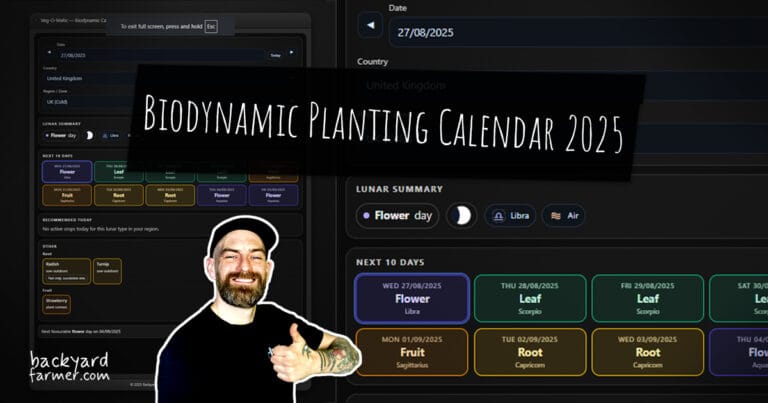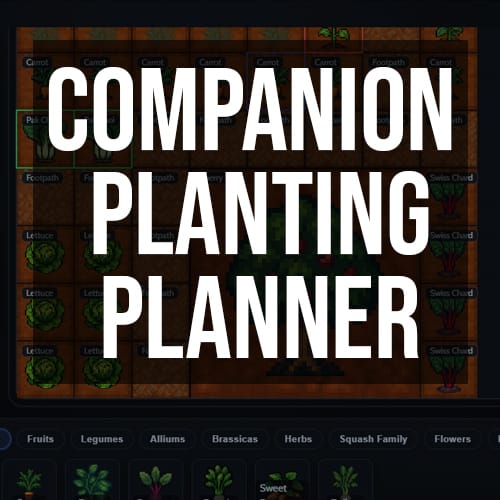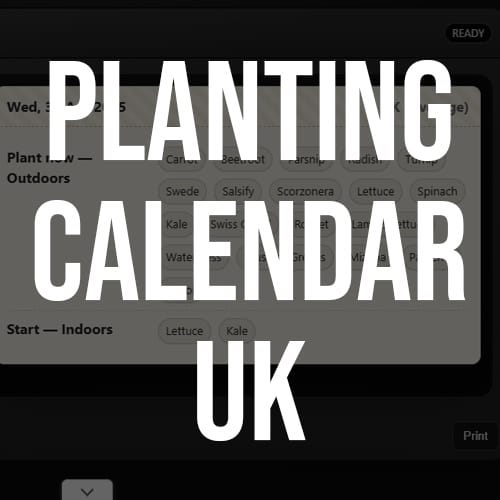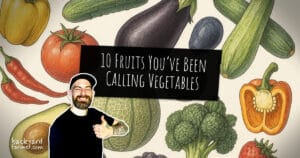Table of contents
- Introduction: Finding the Best Planting Days in 2026
- Best Planting Days vs. Biodynamic Gardening
- What Is a Biodynamic Planting Calendar?
- How the Biodynamic Calendar Works
- Interactive Biodynamic Planting Calendar 2026 (Free Tool)
- How the Biodynamic Calendar Works
- Biodynamic Calendar for the UK (2026)
- Biodynamic Calendar for the US (2026)
- Moon Gardening and Planting by the Signs
- Benefits of Using a Biodynamic Planting Calendar
- Tips for Everyday Gardeners
- FAQs About Biodynamic Gardening
- Conclusion – Your Best Planting Days in 2026
Introduction: Finding the Best Planting Days in 2026
Every gardener asks the same question at the start of a new season: When’s the best day to plant? Whether it’s sowing carrots in spring or transplanting tomatoes in summer, timing often makes the difference between a thriving harvest and a disappointing one. For generations, growers have turned to the moon planting calendar and the stars for guidance, trusting that natural rhythms influence growth both above and below the soil.
This approach, now recognised as biodynamic gardening, blends traditional wisdom with modern ecological thinking.
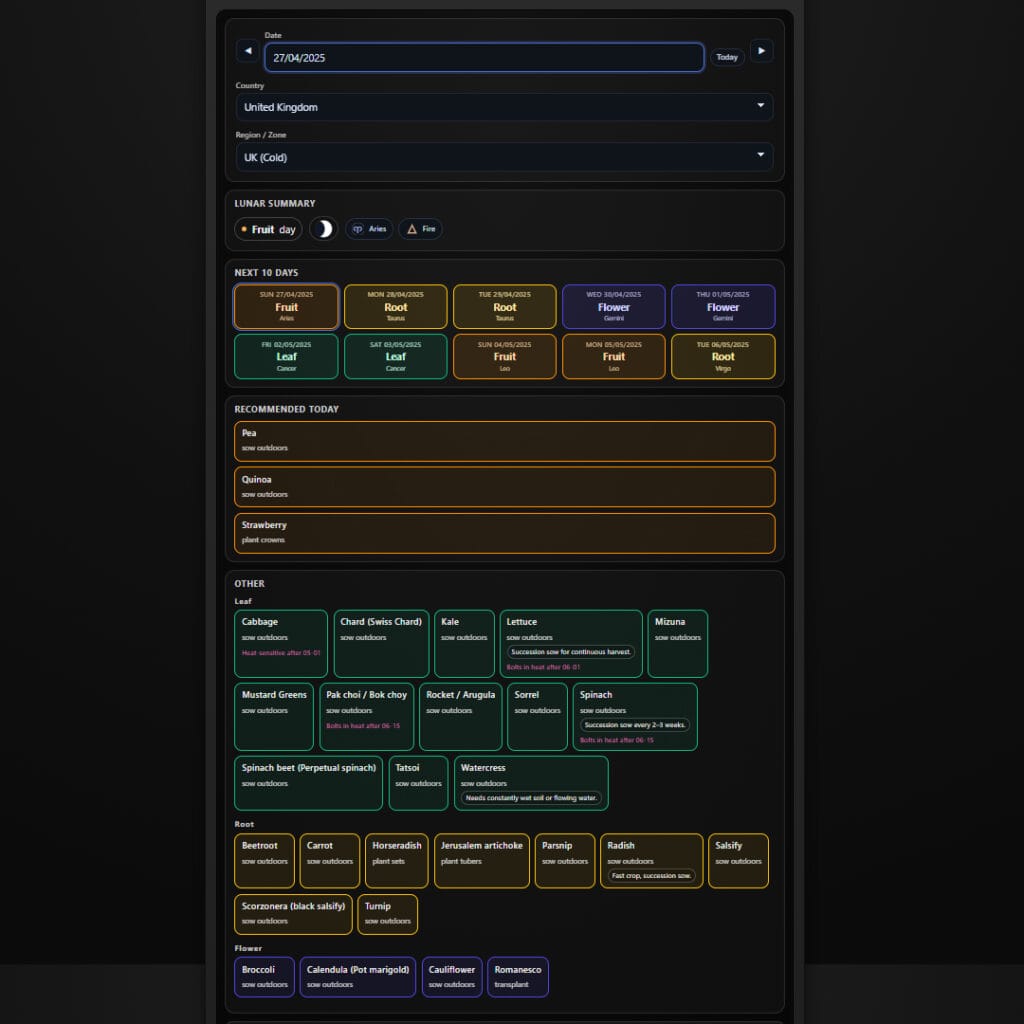
Unlike a standard planting guide that focuses only on frost dates or seasonal markers, a biodynamic planting calendar aligns sowing, transplanting, and harvesting with lunar phases and zodiac signs. The result is a more natural flow—healthier plants, stronger soil, and crops that thrive in step with the seasons.
In this guide, we’ll explore how the Biodynamic Planting Calendar 2026 works, why it matters for UK and US gardeners, and how you can use our free interactive app to find the best planting days for your region.
Whether you’re interested in moon gardening, planting by the signs, or simply want to improve your results, this guide will get you set up for success in 2026.
Best Planting Days vs. Biodynamic Gardening
When most gardeners search for the best planting days, they usually mean the practical side of gardening—when the soil has warmed, the frost risk has passed, and the weather looks promising. These factors matter, but they leave out the deeper natural rhythms that also shape how plants grow.
This is where biodynamic gardening and the biodynamic planting calendar step in. Instead of relying only on seasonal markers, this approach follows the lunar planting calendar, tracking the phases of the moon alongside the zodiac signs. The idea is simple: if the moon can move the tides, it also influences the water in the soil and the way plants absorb nutrients.
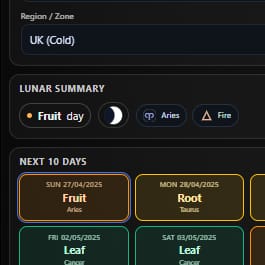
How the Moon Gardening Calendar Works
- Waxing Moon: Energy rises, making it the best time for sowing crops that grow above ground, like leafy greens.
- Waning Moon: Energy flows downward, supporting root crops and transplanting.
- Zodiac Constellations: Add another layer, turning each day into a Root, Leaf, Flower, or Fruit Day, each linked to a specific crop type.
Unlike a static chart, the interactive biodynamic planting calendar updates dynamically for your region and frost dates. Traditional versions, like the Rhythm of Nature Biodynamic Calendar, provide a fixed monthly view, while our tool makes it easier to see tailored recommendations at a glance.
Why This Matters
Together, these cycles don’t just point to the right season—they highlight the exact days that give your plants the best chance to thrive. While traditional gardeners rely on weather alone, those using the biodynamic planting calendar combine good weather and cosmic alignment. The result is healthier crops and a gardening style that feels more connected to natural rhythms.
What Is a Biodynamic Planting Calendar?
A biodynamic planting calendar is more than just a timetable for sowing seeds—it’s a gardening guide that blends traditional wisdom with ecological science. First introduced by Rudolf Steiner in the 1920s, it forms part of his philosophy of biodynamics, which encourages gardeners to work with natural and cosmic forces rather than against them.
How It Works
At its core, the calendar connects lunar cycles, moon phases, and zodiac constellations with everyday gardening tasks. Just as the moon influences tides, many gardeners believe it also affects soil moisture and how plants absorb nutrients. When combined with the four zodiac elements—Earth, Water, Air, and Fire—this system highlights the most favourable times to sow, transplant, prune, or harvest.
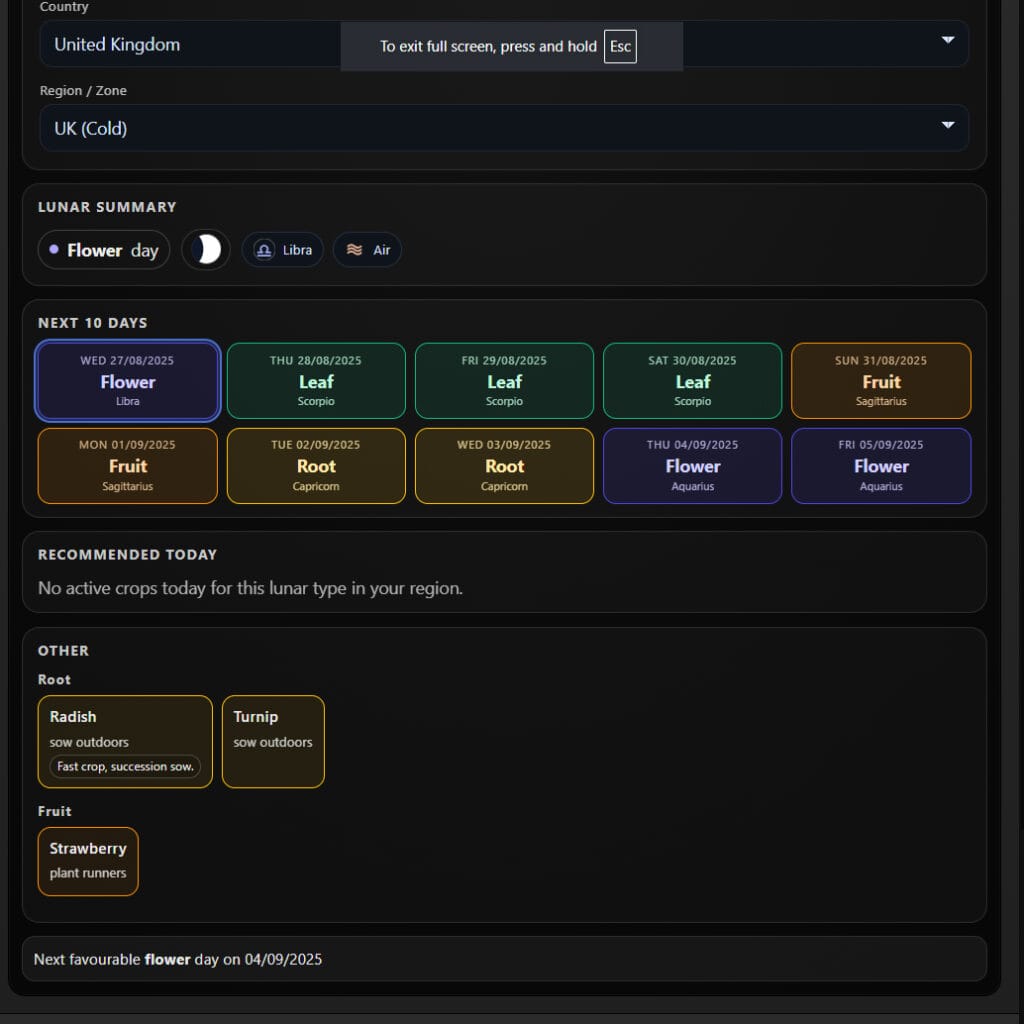
Day Types in the Lunar Planting Calendar
- Root Days (Earth signs: Taurus, Virgo, Capricorn) – best for root crops like carrots, beets, and potatoes.
- Leaf Days (Water signs: Cancer, Scorpio, Pisces) – ideal for leafy vegetables such as lettuce, spinach, and herbs.
- Flower Days (Air signs: Gemini, Libra, Aquarius) – suited for ornamentals, flowering herbs, and pollinator-friendly plants.
- Fruit Days (Fire signs: Aries, Leo, Sagittarius) – perfect for fruiting crops like tomatoes, beans, and peppers.
Why It’s Different
Unlike a standard planting guide that only tracks frost dates, a biodynamic calendar functions as a moon gardening calendar or “cosmic rhythm map.” It helps gardeners align with natural cycles, making planting more intentional, connected, and rewarding.
How the Biodynamic Calendar Works
The biodynamic calendar is built on a simple principle: the moon’s phases and the zodiac signs both influence plant growth. By tracking these cycles together, the lunar planting calendar helps you find not only the right season but also the exact days that give your crops the best chance to thrive.
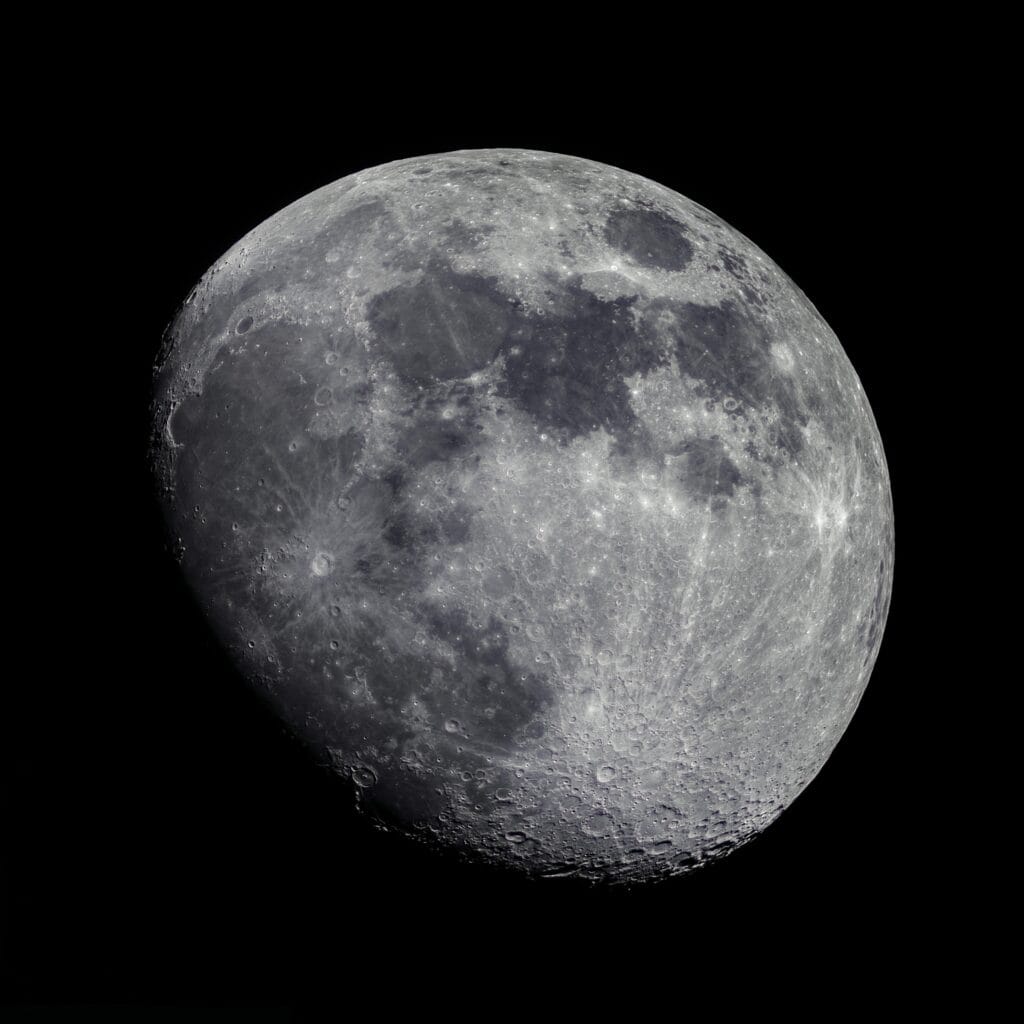
Lunar Phases
- New Moon → Waxing Moon: Energy rises, making it the best time to sow crops that grow above ground, such as leafy greens and tomatoes.
- Full Moon → Waning Moon: Energy shifts downward, which is ideal for root crops, transplanting, and pruning.
- Dark Moon (just before the new moon): Traditionally seen as a pause—best for resting the soil, weeding, or composting.

Zodiac Elements
The twelve zodiac signs are grouped into four elements, each linked to a crop type in the moon gardening calendar:
- Earth (Taurus, Virgo, Capricorn): Root crops
- Water (Cancer, Scorpio, Pisces): Leaf crops
- Air (Gemini, Libra, Aquarius): Flowering plants
- Fire (Aries, Leo, Sagittarius): Fruit crops
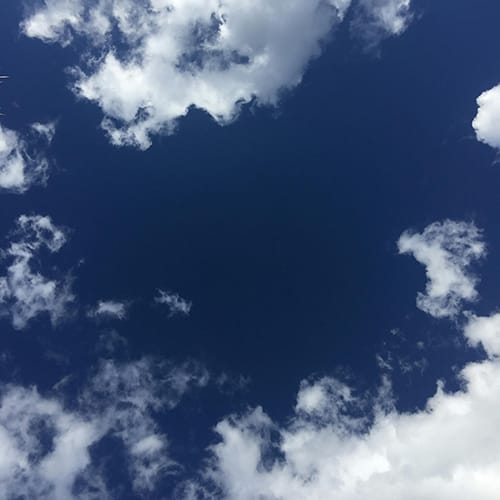
Day Types
Each day is marked as a Root, Leaf, Flower, or Fruit Day, depending on the moon’s position in the zodiac. This clear guide makes planning straightforward: sow potatoes on a Root Day, prune fruit trees on a Fruit Day, or plant lettuces on a Leaf Day.
By combining lunar phases and zodiac elements, the biodynamic planting calendar highlights the best planting days with far more precision than a standard guide. It helps you garden in rhythm with natural cycles, resulting in stronger plants, healthier soil, and more dependable harvests.
Interactive Biodynamic Planting Calendar 2026 (Free Tool)
We’ve created an interactive biodynamic planting calendar tool for 2026 to make lunar gardening simple and practical. Instead of flipping through charts or decoding complex tables, you can quickly check the best planting days for your region with just a couple of clicks.
Key Features
- UK/US Toggle: Switch between regions to get tailored results for your location.
- Regional Adjustments: Built-in frost dates ensure your plan is accurate as well as cosmic.
- Lunar Phases & Zodiac Signs: Instantly see if a day is best for Root, Leaf, Flower, or Fruit crops.
How to Use the Lunar Planting Calendar
- Select Your Region: Choose your area in the UK or US so the planting calendar matches your local climate and frost dates.
- Pick a Date: Click on any day to view its moon phase, zodiac sign, and recommended gardening task.
- Follow the Guidance: Plan your sowing, transplanting, or harvesting around the suggested Root, Leaf, Flower, or Fruit days.
Example Walkthrough
Imagine it’s early May and you want to plant beans in the UK. By selecting your region and checking the calendar, you’ll see the next Fruit Day during a waxing moon—the perfect time for beans. With this clarity, you can plant with confidence knowing you’ve chosen one of the best planting days.
The tool also works as a free moon gardening calendar, making it ideal for anyone who wants a simple way to garden by the moon. Try it out and see how easily the biodynamic planting calendar fits into your everyday gardening routine.
How the Biodynamic Calendar Works
The biodynamic calendar is built on a simple principle: the moon’s phases and the zodiac signs both influence plant growth. By tracking these cycles together, the lunar planting calendar helps you find not only the right season but also the exact days that give your crops the best chance to thrive.
Lunar Phases
- New Moon → Waxing Moon: Energy rises, making it the best time to sow crops that grow above ground, such as leafy greens and tomatoes.
- Full Moon → Waning Moon: Energy shifts downward, which is ideal for root crops, transplanting, and pruning.
- Dark Moon (just before the new moon): Traditionally seen as a pause—best for resting the soil, weeding, or composting.
Zodiac Elements
The twelve zodiac signs are grouped into four elements, each linked to a crop type in the moon gardening calendar:
- Earth (Taurus, Virgo, Capricorn): Root crops
- Water (Cancer, Scorpio, Pisces): Leaf crops
- Air (Gemini, Libra, Aquarius): Flowering plants
- Fire (Aries, Leo, Sagittarius): Fruit crops
Day Types
Each day is marked as a Root, Leaf, Flower, or Fruit Day, depending on the moon’s position in the zodiac. This clear guide makes planning straightforward: sow potatoes on a Root Day, prune fruit trees on a Fruit Day, or plant lettuces on a Leaf Day.
By combining lunar phases and zodiac elements, the biodynamic planting calendar highlights the best planting days with far more precision than a standard guide. It helps you garden in rhythm with natural cycles, resulting in stronger plants, healthier soil, and more dependable harvests.
Biodynamic Calendar for the UK (2026)
Gardening in the UK can be unpredictable. The weather changes quickly, and conditions vary between the north and south, as well as between coastal and inland areas. That’s why the Biodynamic Planting Calendar 2026 (UK) adapts to local differences while staying aligned with the lunar planting calendar and zodiac rhythms. It helps you plan with confidence and find the best planting days for your region.
Seasonal Overview
- Spring (March–May): As daylight increases, sow leafy greens such as lettuce and spinach on Leaf Days during the waxing moon. Root crops like carrots, parsnips, and beetroot perform best on Root Days in late spring. (See this article for more Spring Planting info)
- Summer (June–August): This is the peak season for Fruit Days, ideal for sowing and tending tomatoes, beans, and courgettes. Pollinator-friendly flowers also flourish on Flower Days in midsummer.
- Autumn (September–November): Root vegetables thrive in cooler weather. Parsnips, turnips, and overwintering onions are best sown on Root Days. Sow hardy salad greens on Leaf Days for a late harvest.
- Winter (December–February): Growth slows, but it’s a useful time for soil care, composting, and planning ahead. Use Root Days for pruning fruit trees and preparing beds for spring.
Garlic is especially rewarding when planted on a Root Day—see our full guide on How to Grow Garlic from Old Cloves.
Regional Adjustments
- Mild regions (Southwest, coastal areas): Longer growing windows allow autumn sowings of salad crops and overwintering broad beans.
- Average regions (Midlands, Southeast): Follow standard sowing times, but always double-check frost dates in the interactive tool.
- Cold regions (North, Scotland, uplands): Shorter growing seasons benefit from polytunnels or cloches to extend Leaf crop and Fruit crop sowing windows.
By combining the biodynamic calendar with the UK’s seasonal cycles, you can easily spot the best planting days—whether you’re sowing lettuces in April, planting potatoes in May, or preparing winter crops in the autumn.
Biodynamic Calendar for the US (2026)
The United States covers a huge range of climates—from the frosty Northeast to the subtropical Southeast and the dry West. The Biodynamic Planting Calendar 2026 (US) adapts the lunar planting calendar to these regional differences, helping gardeners across the country find their best planting days with confidence.
Regional Overview
- Northeast: Cold winters and short summers make frost dates essential. Start leafy greens and brassicas indoors on Leaf Days, then transplant after the last frost. Root crops like carrots, beets, and radishes perform best on Root Days in late spring.
- Southeast: With long, warm seasons, multiple sowings are possible. Use Fruit Days for tomatoes, peppers, and melons, and sow lettuce and other greens in spring or autumn on Leaf Days.
- Midwest: Unpredictable frosts mean timing is critical. Corn and beans thrive when sown on Fruit Days after the final frost, while potatoes and other root crops flourish on Root Days during the cooler spring.
- California & West Coast: With a mild, Mediterranean-style climate, the growing season is long. Sow ornamentals and herbs on Flower Days, and use Fruit Days for long-season crops like squash, grapes, and tomatoes.
Why Frost Dates Matter
While the moon gardening calendar guides the timing of sowing and transplanting, frost dates remain the anchor for gardening in the US. The interactive tool combines both—so you’ll know not only which days are cosmically aligned but also which ones are safe for your specific region.
By pairing frost-date awareness with the biodynamic planting calendar, US gardeners can plan with more precision—whether it’s planting corn in the Midwest, tomatoes in California, or leafy greens in the Northeast.
Moon Gardening and Planting by the Signs
Long before the term biodynamic planting calendar was coined, gardeners and farmers followed the practice of moon gardening—timing sowing and harvesting with the phases of the moon. This tradition is still popular today and closely overlaps with the lunar planting calendar used in biodynamics.
What Is Moon Gardening?
The idea is simple: the moon’s gravitational pull doesn’t just move the tides—it also affects water in the soil. During the waxing moon, soil moisture rises, supporting leafy growth above ground. During the waning moon, energy shifts downward, making it an ideal time for root development. This is why many gardeners rely on a moon gardening calendar to plan their crops.
Planting by the Zodiac Signs
In addition to moon phases, gardeners often use the zodiac signs for guidance. Each sign belongs to one of four elements, and each element supports a different crop type:
- Earth Signs (Taurus, Virgo, Capricorn): Best for root crops like carrots, potatoes, and beets.
- Water Signs (Cancer, Scorpio, Pisces): Ideal for leafy vegetables and culinary herbs.
- Air Signs (Gemini, Libra, Aquarius): Associated with flowers and ornamental plants.
- Fire Signs (Aries, Leo, Sagittarius): Strong for fruiting crops such as tomatoes, beans, and squash.
Overlap with Biodynamic Gardening
The biodynamic calendar formalises these traditions by combining moon planting with zodiac influences. For example, sowing beans on a Fruit Day during a waxing moon mirrors the same folk wisdom as planting by the signs, but with a clearer and more structured framework.
In this way, the biodynamic planting calendar acts as a bridge between traditional moon gardening and modern ecological methods. It helps gardeners identify the best planting days while staying connected to natural cycles.
Benefits of Using a Biodynamic Planting Calendar
The biodynamic planting calendar is more than just a symbolic guide—it delivers clear, practical benefits that many gardeners notice in their soil, crops, and overall results. By following the rhythms of the lunar planting calendar and zodiac signs, you can discover your best planting days and garden with more success.
Healthier Crops and Soil Vitality
When sowing and transplanting are aligned with moon gardening cycles, plants often develop stronger roots, grow more vigorously, and resist pests and disease more effectively. Over time, this rhythm builds a balanced ecosystem, where soil and plants support each other naturally.
Better Timing for Key Gardening Tasks
The biodynamic calendar goes beyond sowing dates and also guides transplanting, pruning, and harvesting:
- Root Days: Sow root vegetables for stronger yields.
- Fruit Days: Prune fruit trees to encourage healthier regrowth.
- Favourable Days: Harvest at the right time to improve flavour and storage life.
Working With Natural Rhythms
Instead of working against nature, the lunar planting calendar encourages you to follow its flow. This creates a steady rhythm in your gardening, making it easier to plan ahead and see consistent results season after season.
A Deeper Connection to Gardening
Many gardeners say that using a moon gardening calendar transforms gardening from a simple checklist into a mindful practice. Each task feels intentional and more connected—not just to the soil, but to wider natural cycles as well.
In short, the biodynamic planting calendar doesn’t just tell you when to plant—it helps you uncover the best planting days and shows you how to garden in tune with natural and cosmic rhythms for more reliable and rewarding results.
Tips for Everyday Gardeners
You don’t need to be an expert—or have acres of land—to benefit from the biodynamic planting calendar. Even small-scale gardeners can use this lunar planting calendar to bring more rhythm, structure, and success to their growing routine.
Combine with Companion Planting
Boost results by pairing the biodynamic calendar with companion planting. For example, sow carrots on a Root Day alongside onions to deter pests, or plant beans on a Fruit Day next to sweetcorn for a tried-and-tested duo.
For more on companion planting in action, check out The Three Sisters – A Foodscaping Project. It’s a classic example of how crops can support each other naturally.
Keep a Gardening Journal
Tracking your planting with the moon gardening calendar helps you spot patterns over time. Record what you sowed on which days, then note germination, growth, and yields. This personal record builds confidence and sharpens how you use the biodynamic calendar each season.
Start Small and Stay Practical
If following the biodynamic planting calendar feels overwhelming, start with just one or two crops. For example, try carrots on Root Days and tomatoes on Fruit Days. Once you see the benefits, expanding the practice to your whole garden becomes easy.
Blend with Organic and Permaculture Practices
The biodynamic planting calendar works best when combined with a sustainable gardening approach. Use it alongside composting, mulching, organic methods, and permaculture techniques to improve soil health and long-term fertility.
With only a few small changes, the biodynamic calendar can become part of your everyday gardening—whether you’re tending a backyard patch, managing an allotment, or growing vegetables on a balcony.
FAQs About Biodynamic Gardening
Not exactly. Both avoid synthetic chemicals and focus on building soil health, but the biodynamic planting calendar goes further. It aligns gardening tasks with lunar cycles, moon phases, and zodiac rhythms. Think of it as organic gardening enhanced by a lunar planting calendar.
Yes. Once you understand the basics of Root, Leaf, Flower, and Fruit Days, it’s simple to follow. The interactive biodynamic calendar tool makes it even easier—select your region and date, and it highlights the best planting days for your crops.
The evidence is mixed. Some studies show improvements in soil health and plant vitality, while others find little measurable difference. Still, many gardeners who follow a moon gardening calendar report healthier plants and better yields, which keeps the practice widely used.
A basic moon gardening calendar—focused only on lunar phases—is a good place to start. However, the full biodynamic planting calendar also considers zodiac signs, giving you more detail and precision. It’s similar to moving from a tide chart to a full weather forecast—you’ll have a clearer picture of your best planting days.
Conclusion – Your Best Planting Days in 2026
Every gardener wants to know the best planting days. Weather and frost dates will always play a role, but the biodynamic planting calendar adds another layer by aligning gardening with the lunar planting calendar and zodiac rhythms. This approach helps you work in step with the moon and stars instead of relying only on seasonal markers.
By following Root, Leaf, Flower, and Fruit Days, you can bring more intention to your planting, grow healthier crops, and feel more connected to natural cycles. Whether you’re in the UK or the US, the interactive biodynamic calendar tool makes it easy to check the best planting days for your specific region.
Next Steps
- Try the interactive biodynamic planting calendar 2026 today.
- Explore our Vegetable Planting Calendar for detailed crop-by-crop guidance.
- Learn how to combine the biodynamic calendar with companion planting for even stronger results.
By using the moon gardening calendar and working with natural cycles instead of against them, you’ll not only improve your harvests—you’ll also rediscover the joy in the simple act of growing your own food.
Unlike static calendars like the OrganicSeeds Biodynamic Calendar, our free interactive app lets you dynamically choose the best planting days for your specific UK or US region.
